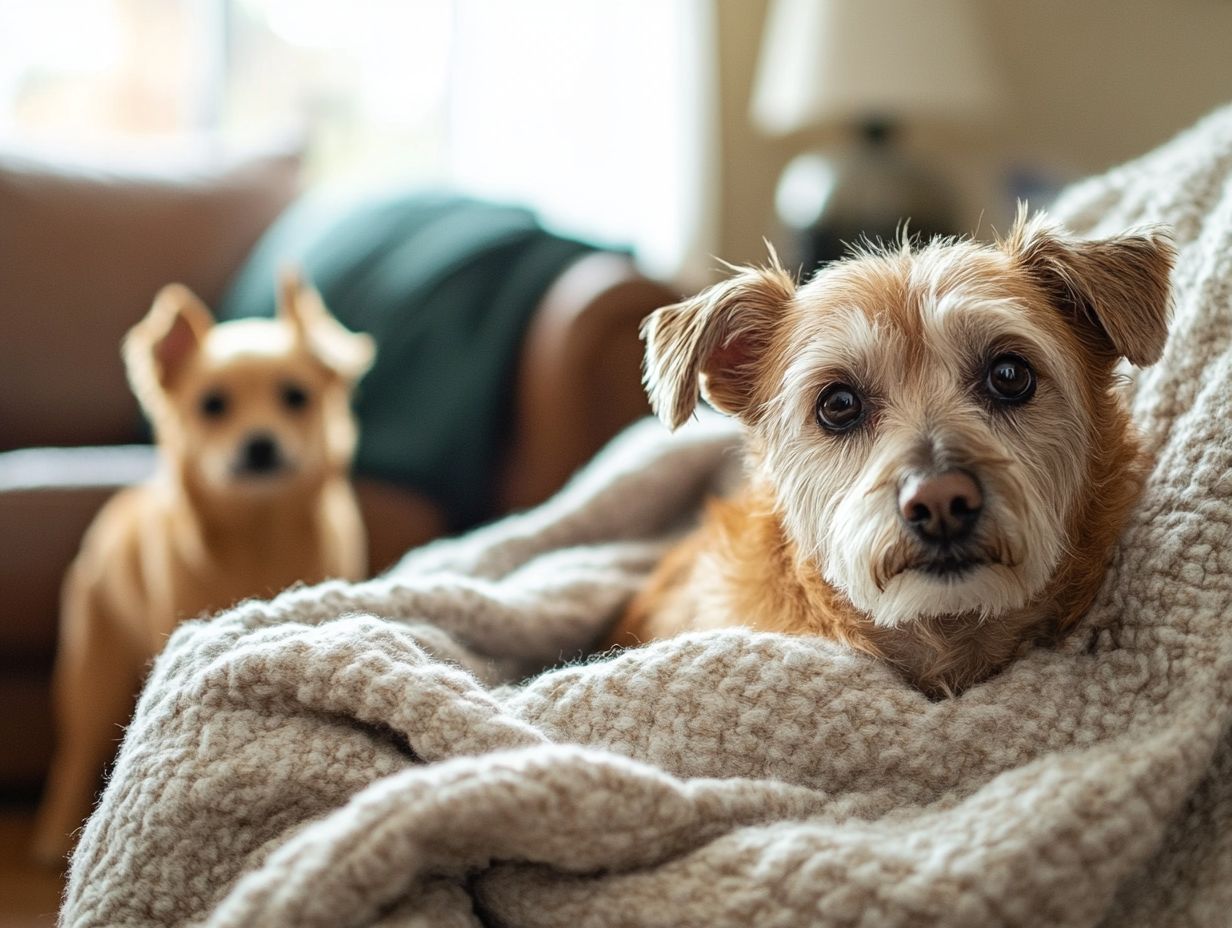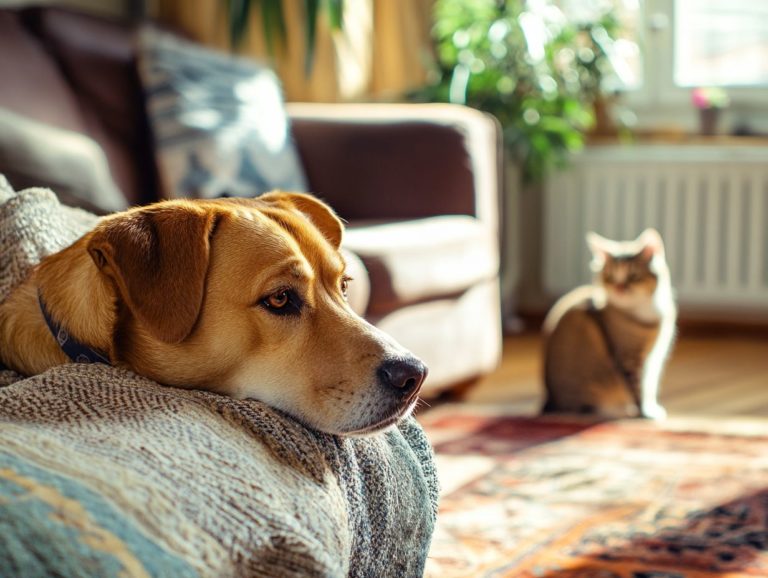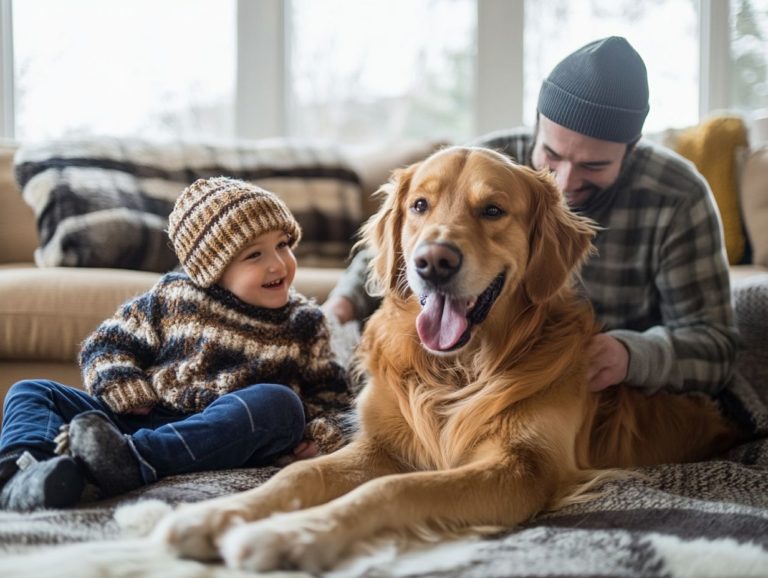How Does Age Affect Pet Anxiety?
As your pets age, you may notice significant changes in their mental and emotional well-being, often resulting in heightened anxiety. Understanding the relationship between age and pet anxiety is essential for you as a pet owner striving to provide the best care possible.
This article delves into the signs of anxiety in pets, the various factors that contribute to it, and effective strategies for management. You’ll find valuable tips on preventing anxiety triggers and special considerations for supporting your aging companions.
Explore with us how to help your furry friends feel more secure and comfortable during their golden years.
Contents
Key Takeaways:
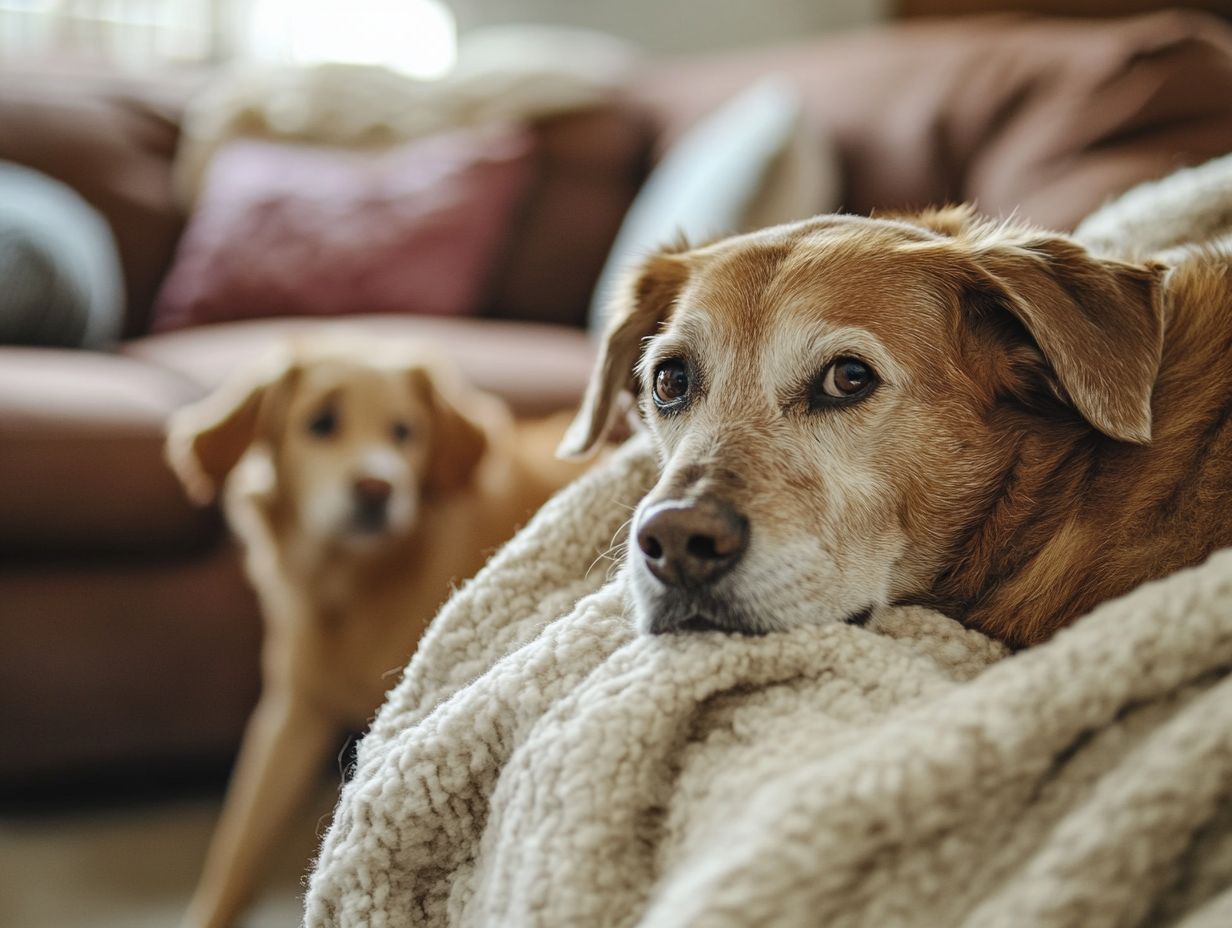
- Age can greatly impact the development and intensity of pet anxiety. Understanding the connection between age and anxiety is crucial for managing and preventing it effectively.
- Identifying behavioral and physical signs of anxiety in pets is essential for early detection and intervention. These signs can vary based on age, so it’s important to be aware of age-specific indicators.
- Various factors can contribute to pet anxiety, including changes in routine, socialization, and medical conditions. By addressing these main reasons, we can help reduce anxiety in our pets.
The Impact of Age on Pet Anxiety
As dogs age, they experience a range of physical and mental transformations that can greatly impact their emotional well-being. This is especially true for senior dogs, who may grapple with anxiety arising from health issues such as arthritis, hearing loss, and Cognitive Dysfunction Syndrome (CDS), which is similar to dementia in humans. Understanding the influence of environment on pet anxiety can also help in addressing these challenges.
Recognizing the link between these age-related changes and anxiety in dogs is essential for both pet owners and veterinarians. Understanding how weather affects pet anxiety enables you to identify tailored solutions and treatment options that cater specifically to the unique needs of older dogs, ensuring they lead a comfortable and fulfilling life in their golden years.
Understanding the Connection
Understanding the link between aging and anxiety is crucial for recognizing how Cognitive Dysfunction Syndrome can impact the emotional well-being of older dogs.
As your dog ages, you might notice a decline in their mental faculties, leading to behavior changes that might worry you. CDS can manifest in various ways, including disorientation, disrupted sleep patterns, and altered responses to familiar commands or stimuli.
These symptoms not only affect your dog’s ability to navigate their surroundings but can also heighten their anxiety and frustration. You may find your once-vibrant pet becoming more withdrawn or irritable. This makes it essential to understand these changes and address them with the right care and support.
By fostering a calming environment for your aging canine, you can help them navigate this challenging phase of life with greater ease.
Signs of Anxiety in Pets
Are you aware of the signs that your pet may be anxious? Spotting these early can save them from distress! Recognizing the signs of anxiety in your pets is crucial for safeguarding their emotional well-being. In older dogs, anxiety symptoms can reveal themselves through various behavioral changes that you must remain vigilant for.
Behavioral and Physical Indicators
Behavioral and physical indicators of anxiety in older dogs can manifest in several ways, including excessive barking, destructive tendencies, and pronounced signs of separation anxiety when they find themselves alone.
You may notice symptoms taking shape through pacing or restlessness, where your dog seems unable to find a comfortable spot, often circling obsessively in one area. Changes in appetite can also arise; your dog might suddenly refuse to eat or, conversely, overindulge as a way to cope with stress both of which are concerning for their health.
Unintentional shaking or trembling can serve as a clear indicator of distress, while excessive grooming or licking could reveal deeper anxiety issues. Dogs might also choose to hide or seek refuge in unfamiliar locations, shunning social interaction, which further reflects their mental state.
By closely observing these signs, you can provide the essential support and interventions needed to alleviate your furry friend s anxiety. Act now to help your furry friends feel secure during these challenging times!
Causes of Pet Anxiety
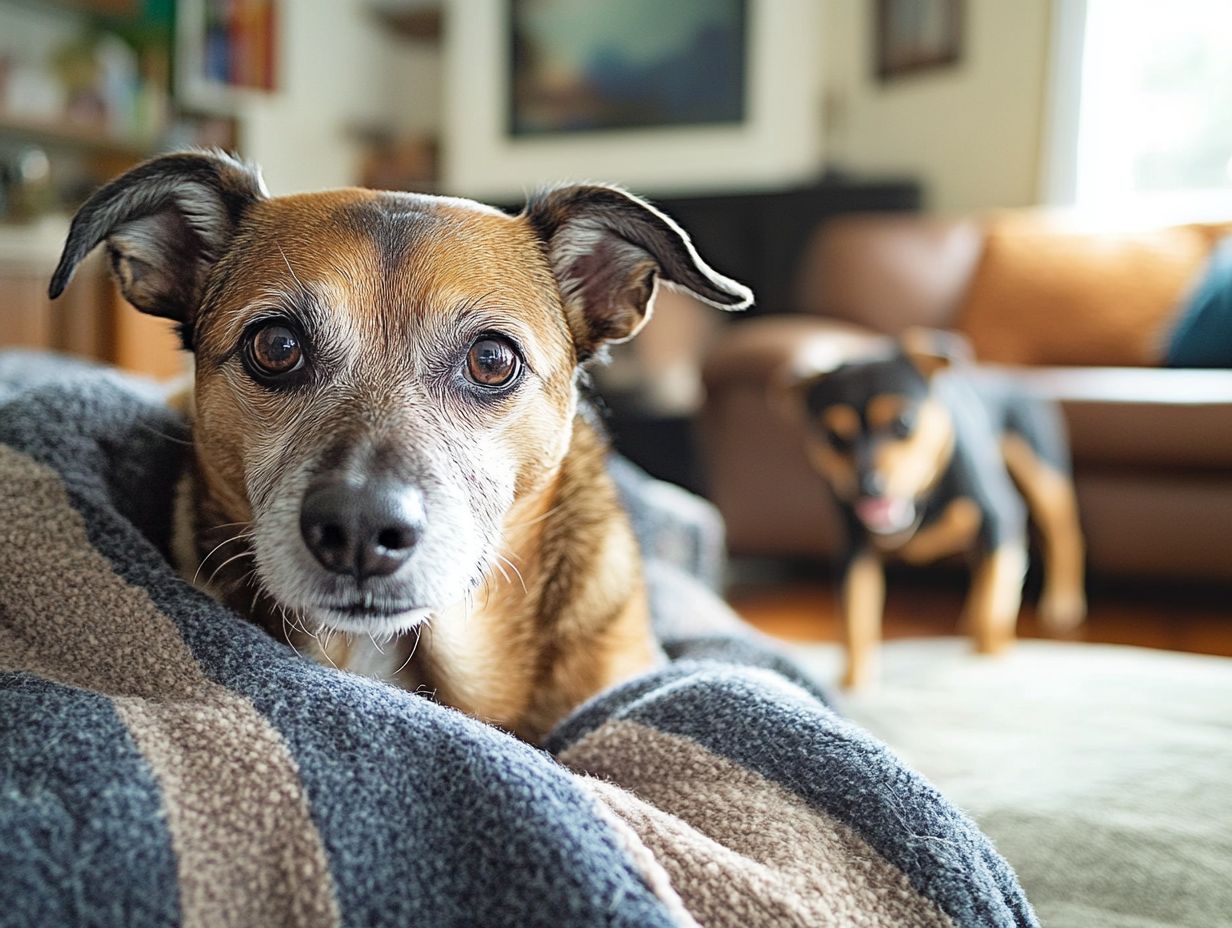
Understanding the causes of pet anxiety is crucial, particularly in senior dogs. Various factors, such as underlying medical conditions, environmental changes, and stressors, can significantly impact their anxiety levels. To learn more about this, check out how anxiety affects a pet’s daily life.
By recognizing these elements, you can better support your furry companion and enhance their quality of life.
Factors That Contribute to Anxiety
Several factors contribute to anxiety in older dogs, including issues with thinking and memory, changes in their environment, and heightened stress levels that come with aging. Understanding whether pet anxiety is becoming more common can help owners address these concerns effectively.
As dogs grow older, they often face a decline in cognitive function. This can present itself as disorientation, memory loss, or disrupted sleep patterns. It’s important to understand that it is normal for pets to have anxiety, and each of these factors can significantly amplify their anxiety.
Environmental shifts, such as moving to a new home, welcoming new pets, or alterations in the family dynamic, can instill a sense of uncertainty and confusion, intensifying their stress.
Familiar sounds that once brought comfort might suddenly trigger fear or distress, complicating their ability to adjust. This escalated anxiety affects their emotional well-being and can also lead to physical health problems.
Caregivers should actively identify and tackle these stressors to enhance the overall quality of life for their older companions.
Managing Pet Anxiety
Effectively managing pet anxiety requires a multifaceted approach. Begin by identifying the symptoms of anxiety in your pet, as this lays the groundwork for understanding their needs.
Consider exploring veterinary treatment options, such as CBD oil, particularly for older dogs, to provide them with the relief they deserve.
Effective Strategies and Techniques
Strategies for managing anxiety in older dogs include behavioral training, environmental enrichment, and incorporating products like CBD oil into their veterinary treatment plan.
By combining these approaches, you address the immediate symptoms and cultivate a sense of security and comfort in your dog s daily life. Tailoring a routine with gentle, positive reinforcement techniques can significantly uplift their emotional well-being.
Creating a safe haven at home, filled with familiar scents and soft bedding, can greatly minimize stress triggers.
Regular consultations with a veterinarian are crucial. They can assist you in formulating an effective treatment plan. This plan may include recommended dietary supplements and guidance on administering medications correctly to achieve optimal results.
Preventing Pet Anxiety
To prevent pet anxiety, especially in senior dogs, it’s essential for you to recognize common triggers and employ proactive strategies that can alleviate anxiety before it intensifies.
Understanding your dog’s unique needs and responding thoughtfully will create a more peaceful environment for them.
Tips for Reducing Anxiety Triggers
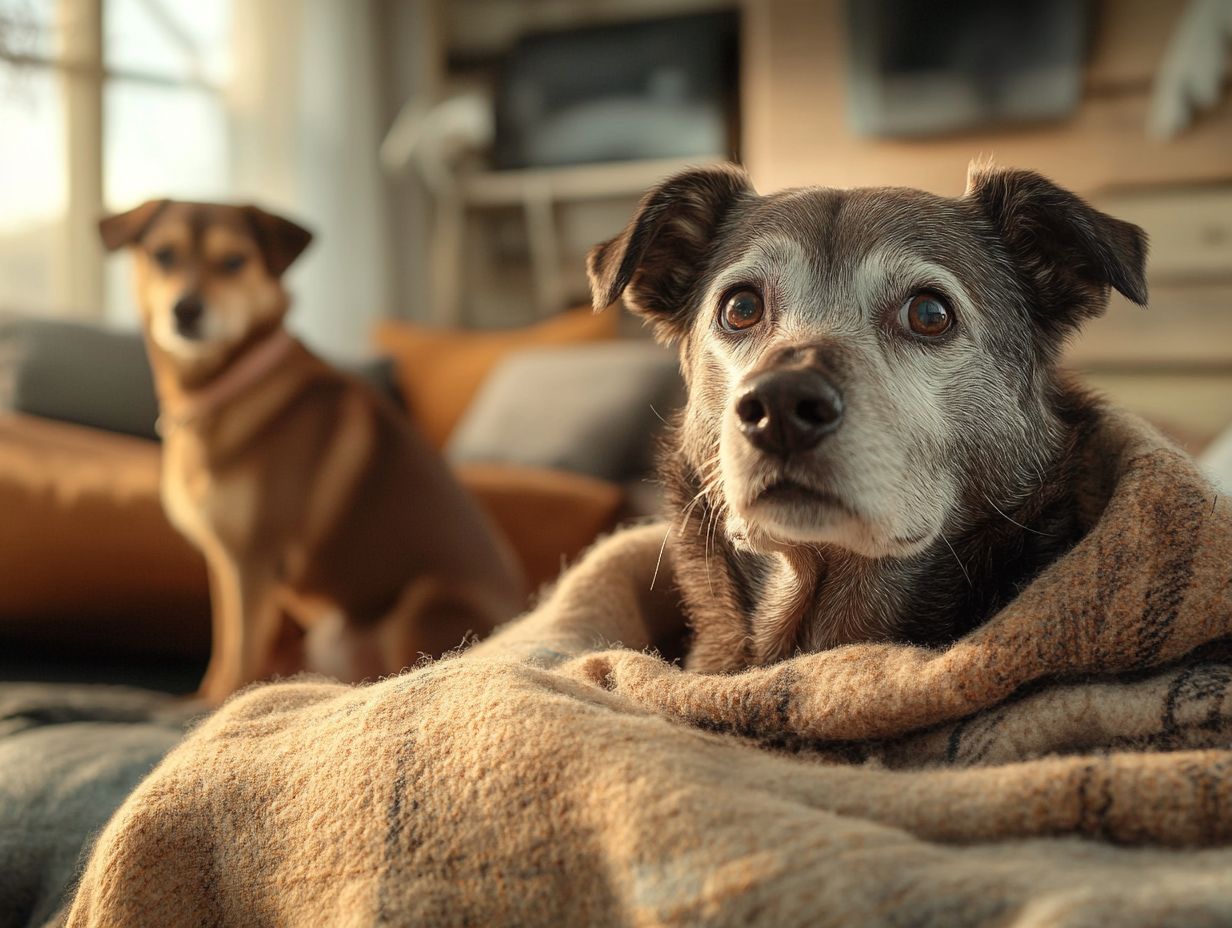
To effectively reduce anxiety triggers in your senior dog, implement strategies focusing on maintaining a stable environment and introducing rehabilitation techniques.
Creating a calm atmosphere is key. Achieve this by adhering to a consistent daily routine where feeding, walks, and playtime occur at the same times each day.
Minimizing sudden loud noises think thunder or construction sounds can significantly help in lowering anxiety levels.
You might also want to consider calming supplements or pheromone diffusers, which can work wonders in providing a soothing effect. Incorporating gentle physical therapy or hydrotherapy into your dog s regimen promotes mobility and instills a sense of security, which is crucial for alleviating stress.
Ultimately, your goal is to create a nurturing environment where your senior dog feels safe and comfortable.
Learn more about how to support your pet s anxiety today!
Supporting Aging Pets with Anxiety
Supporting aging pets with anxiety involves careful attention and tailored care tips that prioritize their special needs. By understanding these aspects, you can truly enhance their quality of life, even in the face of anxiety challenges.
Special Considerations and Care Tips
When caring for aging pets with anxiety, you must implement special considerations that prioritize their emotional well-being and overall health, especially regarding whether anxiety in pets is a behavioral issue.
Creating a safe and comfortable environment is key. Incorporate familiar smells, sounds, and textures to help reduce stress and promote relaxation.
Engaging in gentle physical activities, like short walks or light play, supports their physical health while providing an outlet for any pent-up energy.
Don t forget about mental stimulation! Puzzle toys or interactive games can keep their minds active, which is especially important for older dogs. Establishing a consistent daily routine will also offer them a sense of security, helping them manage their anxiety more effectively.
By combining these thoughtful approaches, you ll ensure their emotional comfort and contribute positively to their long-term well-being.
Frequently Asked Questions
What is pet anxiety and how does it manifest in animals?
Pet anxiety is a condition where animals experience excessive and persistent fear, stress, and worry. It can manifest in various ways, such as constant pacing, shaking, destructive behavior, or aggression.
How does age affect pet anxiety?
Just like humans, pets can also experience anxiety at different stages of their life. As pets age, they may become more prone to developing anxiety due to changes in their physical health and surroundings, making it important to learn how to recognize anxiety in older pets.
Why do older pets tend to experience more anxiety?
Older pets may have more difficulty adapting to change or may experience age-related health issues that contribute to anxiety. To better understand this, it’s helpful to explore what to know about anxiety in senior pets, which can include hearing or vision loss, cognitive decline, or mobility issues.
What are the signs that my senior pet may be suffering from anxiety?
Some signs to look out for include increased restlessness, excessive vocalization, changes in appetite, and avoidance of certain activities or people. It’s important to consult with a veterinarian to rule out any underlying health issues.
Can anxiety in older pets be treated?
Yes, there are various treatments available to help manage anxiety in older pets. This can include behavior modification techniques, which are methods to change how pets behave, medication, and environmental changes to reduce triggers and promote a sense of calmness. Additionally, understanding how fostering affects pet anxiety levels can also provide valuable insights for caregivers.
How can I help my senior pet cope with anxiety?
There are several things you can do to help your pet cope with anxiety, such as creating a safe and comfortable environment, providing regular exercise and mental stimulation, and maintaining a consistent routine. Seeking guidance from a veterinarian or animal behaviorist can also be beneficial.

